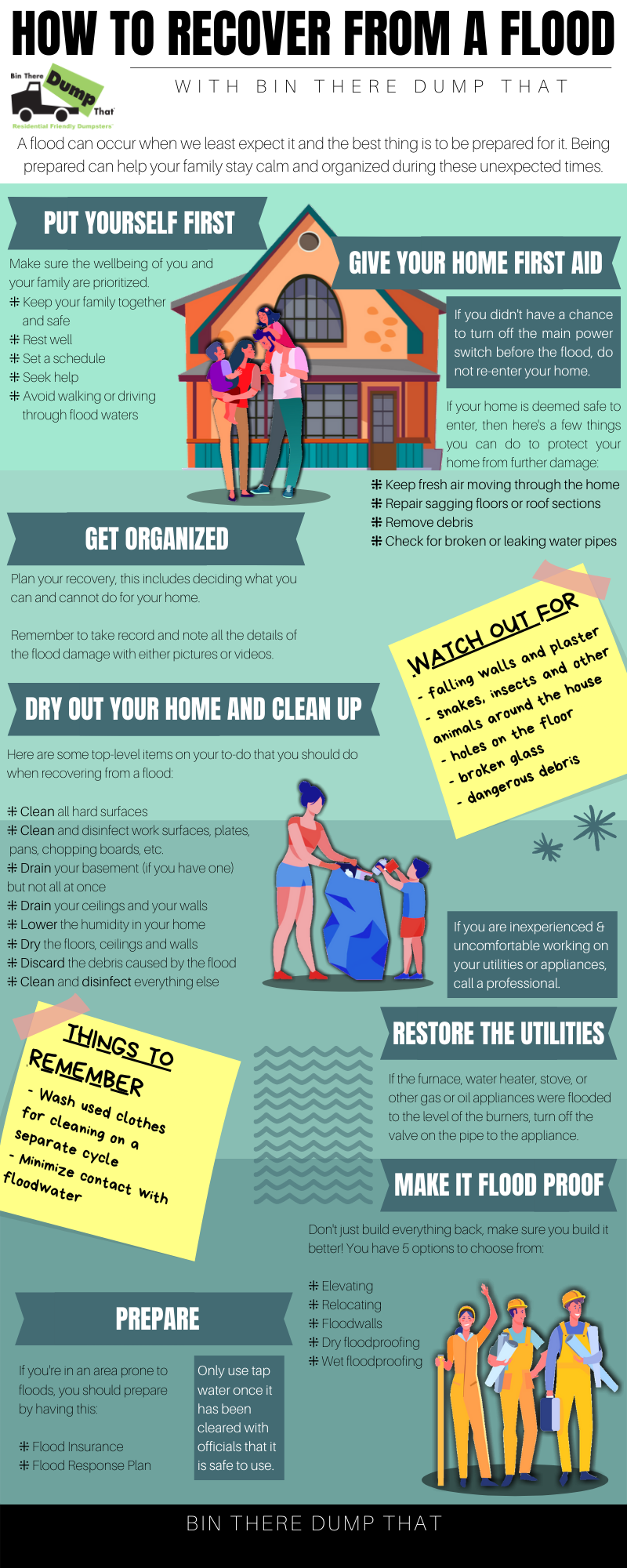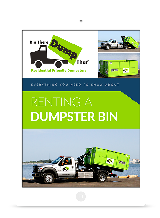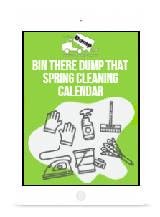How to Deal with a Flood and a Flood Recovery Process
A flood can occur when we least expect it and the best thing is to be prepared for it. Being prepared can help your family stay calm and organized during these unexpected and difficult times. We want to help you recover as soon as possible. First, we need to make sure that you’re well educated on preparation for a flood as well as how to recover from a flood.
We’ve included an infographic that you can quickly save and use as a reference on how to go through the steps of flood recovery which gives you top-level tasks and important information to remember when dealing with a flood.
How to Prepare for a Flood
When you get notified from news outlets that there’s a flood there are a few things that you can do to alleviate the heavy lifting later on during the flood recovery process. Here are a few things that you should do to prepare for a flood hits your area:
- Fill plastic bottles with clean water for drinking.
- Fill bathtubs and sinks with water for flushing the toilet or washing the floor or clothing.
- Fill your car's gas tank, in case you need to evacuate.
- Bring outdoor belongings, such as patio furniture, indoors.
- Turn off propane tanks to reduce the potential for fire.
- Move your furniture and valuables to higher floors of your home.
- Turn off utilities if told to do so by authorities to prevent damage to your home or within the community. If you shut your gas off, a professional is required to turn it back on.
- Unplug small appliances to reduce potential damage from power surges that may occur.
If your area is prone to floods, then you’ll need to attempt to prevent flood damage by putting a weather protection sealant around the basement and/or the base of ground-level doors. An easy way to prevent damage to important documents is to store them on higher levels in your home.
A Grab and Go Bag
We’ve created a checklist to help you keep your items in order. If you want to be extra prepared, make sure that you have this already packed!
During a Flood
During the flood, if you’ve evacuated your home, keep your radio on and accessible to find out what areas are affected and what roads are safe for you to travel on. Follow emergency routes provided by local authorities and officials.
Here are things you need to keep in mind while moving:
- If you are moving on foot, the fast water could sweep you away
- If you are in a car, do not drive through flood waters or underpasses
- If your car stalls, leave it and save yourself and your passengers
After a Flood
- Put Yourself First
- Give your Home First Aid
- Get Organized
- Dry Out Your Home
- Restore the Utilities
- Rebuild and Flood Proof
- Prepare

Share this Image On Your Site
Step 1 - Put Yourself First
The first step to flood recovery is to make sure you and your family are safe. That should be your number one priority. Before you start tackling your recovery, you should rest and assure that you’re in the right state of mental and physical health to be undergoing a stressful setting.
Set a schedule for yourself to organize your to-do list. Check off everything that you need to do and schedule when it should happen so that you don’t miss and/or forget anything.
Step 2 - Give Your Home First Aid
When you’re ready to tackle the rest of the steps to flood recovery, the next step is to give your home some first aid to prevent any further damage by the flood. Before any of this, you’ll need to make sure it is safe for you to go back into your home.
AN IMPORTANT THING TO NOTE:
If the main power switch was not turned off prior to flooding, do not re-enter your home.
Many household items and food that have been damaged by the flood have to be discarded because the flood water can be toxic.
Protect your home from further damage by letting fresh air move through your home and remove debris in and around the house. Check for broken or leaking water pipes and repair those and sagging floors and roof sections so they don’t collapse in on itself.
Step 3 - Get Organized
The next step in your flood recovery plan once you’re able to get into your home it’s time to get organized. Once you’ve assessed your home, this is when you’ll have to decide what you can and cannot do but also make sure it’s safe to work in your home.
For insurance purposes, make sure that you take notes on all the flood damage and record them by photograph or video. Keep all receipts if you purchase/fix anything and an inventory list of everything you’ve lost.
Step 4 - Dry Out Your Home
Drying out your home will be the next step in your flood recovery plan - preventing damage means that floodwaters shouldn’t be present. There are 3 ways that flood waters affect your house:
- Water damages materials. Wood can swell, warp, and rot. Electrical parts short out, malfunction and cause fires and electrical shocks. Learn more about electrical safety tips for flooding disasters here.
- Contaminants in the water get everything dirty. Floodwater can be heavily contaminated with sewage and other pollutants. Contact and bad hygiene can cause sickness and infections.
- Dampness promotes mildew, mold and fungus. Move items to a cool, dry area within 48 hours and set up fans to promote drying.
Here are some top level things that you can do to help speed up the drying process in your flood recovery:
- Drain basements slowly to ensure the walls don’t cave in
- Drain ceilings and your walls
- Lower the humidity in your home by opening your windows
- Dry floors
- Discard debris
During this process, it's probably time to rent a dumpster which you can share with the neighborhood. Our residential friendly dumpster will help with the strain of discarding heavy debris and furniture. Instead of having to toss the dumpster over tall walls, you're able to walk them through our double doors.
We have several different dumpster sizes for flood restoration. From a 6 yard dumpster if you've only experienced a basement or garage flood and only need to rid yourself of smaller items to a 15 and 20 yard dumpster for a natural flood.
Step 5 - Restore the Utilities
You’re most likely going to have to replace gas or oil appliances if they were flooded to the level of the burners. If you want to keep a gas or oil appliance, have it cleaned professionally.
If you are not experienced or comfortable working on your utilities or appliances, please call a professional.
Step 6 - Rebuild and Flood Proof
When you’re rebuilding, make sure you find a trusted contractor in your area with trusted services.
Remember, local businesses were devastated too and if they have the capacity to help their community, they will. They, too, are going through the steps of flood recovery.
There are 5 different ways to flood proof your home:
- Elevation
- Relocation
- Floodwalls
- Dry floodproofing
- Wet floodproofing
Step 7 - Prepare
Develop a flood recovery plan for the next flood. If your area is prone to flooding, then it’s best to stay prepared and ready for the next one.
Request a Free Quote Near You!
Friendly, professional customer service, plus fair pricing, equals value.
Request a Free QuoteFREE EBOOK

Everything you need to know about renting a dumpster
Download NowFREE INFOGRAPHIC

Skip The Gym and Burn Calories While Doing Your Household Chores
Learn MoreFREE CALENDAR DOWNLOAD

28 Day Cleaning Schedule
Download Now
